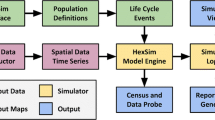Abstract
The current Mexican environmental law provides the legal basis for comprehensive land-use planning. Under the law, development of natural ecosystems must combine goals, policies, and practices towards the sustainable use of natural resources and the protection of biological diversity. Thus, ecosystem manipulation must be able to counter fragmentation of natural ecosystems and isolation of natural reserves, while providing for human needs. Assessment of the potential of natural ecosystems and management impacts are required. Multiple-resource simulation is an assessment and land-use planning tool that permits managers and decision makers to comply with the law, providing a flexible, user-oriented system that can meet the needs of managers, conservationists, and researchers. A multiple-resource model and an example of how it can be applied to meet planning needs is presented for discussion.
Similar content being viewed by others
Literature Cited
Blake, J. G., and J. K. Karr. 1984. Species composition of bird communities and the conservation benefit of large versus small forests.Biological Conservation 30:173–187.
Bojórquez, L. A. 1987. Multiple-resource modeling in forest and woodland ecosystems of Arizona. PhD dissertation. University of Arizona, Tucson. 187 pp.
Conacher, A. 1980. Environmental problem-solving and land-use management: a proposed structure for Australia.Environmental Management 4:491–405.
Diamond, J. M. 1976. Island biogeography and conservation: strategy and limitations.Science 193:1027–1029.
Diario Oficial. 1988a. Ley general del equilibrio ecológico y la protección al ambiente. Diario Oficial de la Federación, January 28:23–57.
Diario Oficial. 1988b. Reglamento de la ley general de equilibrio ecológico y la protección del ambiente. Diario Oficial de la Federación, July 7:28–36.
Diario Oficial. 1988c. Reglamento de la ley forestal. Diario Oficial de la Federación, July 13:7–41.
Ffolliott, P. F., K. Brooks, and D. Guertin. 1984. Multiple-resource modeling—lake states' application.North Journal of Applied Foresty 1:80–84.
Forman, R. T., and M. Godron. 1986. Landscape ecology. John Wiley & Sons, New York. 619 pp.
Gilbert, L. 1979. Food web organization and the conservation of neotropical diversity. Pages 1–13in M. Soulé and B. A. Wilcox (eds.), Conservation biology: an evolutionary-ecological perspective. Sinauer Associates, Sunderland, Massachusetts.
Harris, L. D. 1984. The fragmented forest: island biogeography theory and the preservation of biotic diversity. The University of Chicago Press, Chicago, 202 pp.
Hollick, M. 1981. Environmental impact assessment as a planning tool.Journal of Environmental Management 12:79–90.
Karr, J. R. 1987. Biological monitoring and environmental assessment: a conceptual framework.Environmental Management 11:249–256.
Kushlan, J. A. 1979. Design and management of continental wildlife reserves: lessons from the Everglades.Biological Conservation 15:281–290.
Larson, F. R., P. F. Ffolliott, and D. R. Carder. 1978. Estimating impacts of silvicultural management practices on forests ecosystems. Pages 281–294in R. C. Loehr, D. A. Haith, M. F. Walter, and C. S. Martin (eds.), Best Management Practices for Agriculture and Silviculture. Ann Arbor Science, Ann Arbor, Michigan.
May, R., J. R. Beddington, J. W. Horwood, and J. G. Shepherd. 1978. Exploiting natural populations in an uncertain world.Mathematical Biosciences 42:219–252.
Miller, R. I., and L. D. Harris. 1977. Isolation and extirpations in wildlife reserves.Biological Conservation 12:311–315.
Munn, R. E. (ed.). 1975. Environmental impact assessment: principles and procedures. Scope, Toronto, Canada. 173 pp.
Naveh, Z. 1978. The role of landscape ecology in development.Environmental Conservation 5:57–63.
Newmark, W. D. 1985. Legal and biotic boundaries of western North American national parks: a problem of congruence.Biological Conservation 33:197–208.
Noss, R. F. 1987a. Corridors in real landscapes: a reply to Simberloff and Cox.Conservation Biology 1:159–164.
Noss, R. F. 1987b. Protecting natural areas in fragmented landscapes.Natural Areas Journal 7:2–13.
Noss, R. F., and L. D. Harris. 1986. Nodes, networks, and MUMs: preserving diversity at all scales.Environmental Management 10:299–309.
Okigbo, N. B. 1980. Development of multiple-use management for tropical forest through research in Africa. Pages 3–9in IUFRO/MAB conference: research on multiple use of forest resources. US Forest Service, General Technical Report WO-25.
Patten, B. C. 1972. A simulation of the shortgrass praire ecosystem.Simulation 19:177–186.
Petak, W. J. 1980. Environmental planning and management: the need for an integrative perspective.Environmental Management 4:287–295.
Prins, H. H. 1987. Nature conservation as an integral part of optimal land use in East Africa: the case of the Masai ecosystem in northern Tanzania.Biological Conservation 40:141–162.
Rasmussen, W., and P. F. Ffolliott. 1981. Simulation of consequences of implementing alternative natural resources policies. Pages 41–43in P. Ffolliott and G. Halfter (tech. coor.), Social and environmental consequences of natural resources policies, with special emphasis on biosphere reserves. Proceedings of the international seminar. US Forest Service Rocky Mountain Forest and Range Experimental Station General Technical Report RM-88.
Ridd, M. K. 1965. Area-oriented multiple use analysis. US Forest Service. Intermountain Forest and Range Experimental Station Research Paper INT-21. 14 pp.
Ripley, T. H., and D. O. Yandle. 1969. A system analysis—ecological control approach to multiresource forest management.Journal of Forestry 67:806–809.
Rzedowski, J. 1978. Vegetación de México. Limusa, México, D.F. 432 pp.
SARH. 1987. Ley forestal. Secretaría de Agricultura y Recursos Hidraúlicos. México, D.F. 16 pp.
Schonewald-Cox, C. M., and J. W. Bayless. 1986. The boundary model: a geographical analysis of design and conservation of nature reserves.Biological Conservation 38:305–322.
Soulé, M. E., and D. Simberloff. 1986. What do genetics and ecology tell us about the design of nature reserves.Biological Conservation 35:19–40.
WGWMD. 1987. Sustainable growth and development: the role of watershed management. Statement prepared by the Working Group on Watershed Management and Development. University of Minnesota's Forestry for Sustainable Development Program St. Paul, Minnesota. 24 pp.
Wilson, E. O., and E. O. Willis. 1975. Applied biogeography. Pages 522–534in M. L. Cody and J. M. Diamond (eds.), Ecology and evolution of communities. Belknap Press of Harvard University, Cambridge, Massachusetts.
Author information
Authors and Affiliations
Rights and permissions
About this article
Cite this article
Bojórquez-Tapia, L.A., Ffolliott, P.F. & Guertin, D.P. Multiple-resource modeling as a tool for conservation: Its applicability in Mexico. Environmental Management 14, 317–324 (1990). https://doi.org/10.1007/BF02394199
Issue Date:
DOI: https://doi.org/10.1007/BF02394199




